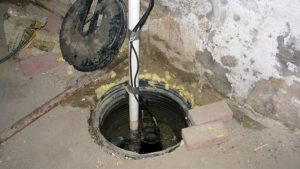When you refer to our ultimate sump pump comparison chart, you will notice that the products we’ve listed include many of the quietest pumps available in the market. The reason for this is that sump pumps, being essentially motor pumps running on electricity/water, are often, quite justifiably in case of older pumps, considered a menace to the tranquillity of the house. While choosing the pumps we’ve mentioned therein will surely reduce the noise issues, there are also a number of sump pump noise problems and solutions which require only a little time and patience on your part.

Problem 1: Loud “thud” noise when pump shuts off
The “thud” sound produced at the end of a sump pump running cycle comes not from the pump, but from the check valve associated with the PVC pipes. These valves are in place to ensure that once the pressure of water flowing from the sump falls, there is no back flow of water into the sump. As the water pressure falls and water tries to return to the sump under the influence of gravity, the valve shuts close, producing the “thud” sound.
Solution 1: Install a silent check valve
A silent check valve ensures that the thudding sound is not produced. While a costly option as far as sump pump noise problems and solutions are concerned, this is the only permanent answer. Once you’ve purchased a silent check valve, you can:
- Shut off the check valve and any other valves that may exist above it.
- Remove the existing check valve. Drain any water that may have collected in the vicinity of the valve.
- Cut the pipe or add attachments to make the PVC pipe fit the new silent check valve dimensions.
- Attach the check valve and reconnect the other valves. Turn them all on and test using a bucket of water drained into the sump.
Note: A “quiet check valve” is not a silent check valve. Silent check valves are a separate, somewhat costly category of valves.
Solution 2: Attach valve at 45 degrees
This solution is somewhat cheaper but trickier to implement. To do it:
- Remove the check valve using the above steps.
- Cut the pipes above and below the check valve such that the edges nearest to the valve are diagonal in shape. Hold the valve loosely in between the two diagonal edges to gain a better idea of whether further cutting is needed.
- Tilt the valve at 45 degrees and attach the valve securely. If there are any discrepancies, you should use proper connectors.
Note: The diagonal cuts are permanent and cannot be changed unless the entire pipe setup is modified.
Problem 2: Motor makes a lot of noise when running
A regular candidate among sump pump problems and solutions, especially among older pumps, this problem can be solved most effectively by choosing one of the many quiet sump pumps we mentioned in our sump pump buying guide. If buying a new pump is not possible though, a number of stop-gap solutions are available:
Solution 1: Make sump cover airtight
- Remove your existing sump cover and note the thickness of the plastic. If it is very thick but still noise comes out, there may be perforations in the cover, or it may have become weak over time. If it is thin, it cannot be expected to prevent noise pollution anyhow.
- If the cover is thick and has holes/perforations, cover these with small pieces of foam or cork. Foam is advisable because it is more resistant to water damage.
- If the cover has become intrinsically weak or is too thin, you can reinforce it with a layer of insulating foam, applied on the surface which will face the sump pump.
- Alternatively, you can buy an insulation-inclusive sump pump cover as well.
Solution 2: Rubber grommets
- If the cover is loose or rattles during heavy pumping, measure out its circumference.
- Choose rubber grommets of appropriate size and shape and apply them to the sides of the sump cover.
- Once fitted in this manner, apply the sump cover to the sump and seal it if necessary.
Problem 3: Clanging Sounds when water flows out
Clanging is another common category of sump pump noise problems and solutions, and occur when the pipes are not properly secured against their holders, leading to the pipes banging against the holders and creating noise that reverberates across the walls. To solve this:
Solution 1 – Rubber grommets
- Measure out the gaps between the pipe and the holders.
- Take rubber grommets of appropriate dimensions and fit them into the spaces, such that pipe fits snugly.
Note: These steps can also be carried out at the time of learning how to install a sump pump, though in most cases, some follow up grommet installation needs to be carried out as well.
Solution 2 – Align all pipes at 45 or 90 degrees
- Using a levelling tool figure out the plane of the basement floor.
- Now measure out the angles of the various pipes stemming from the sump pump. They should be at 45 or 90 degrees (or parallel) to the plane.
- Tighten holders and straighten the pipe to ensure that sections which do not conform to these angles are fixed.
Conclusion
While discussing the type of sump pumps – which is best choice, we argued that some types of sump pumps eg. submersible sump pumps, make less noise compared to pedestal sump pumps. While it is extremely convenient and beneficial to purchase a new sump pump, we also recognize that it is not always possible to do so, especially if the product was purchased a few months ago with sub-standard fittings and these have started to weaken and rust. In such circumstances, the above paragraphs should help you find your way through sump pump noise problems and solutions without having to call in professional assistance.



